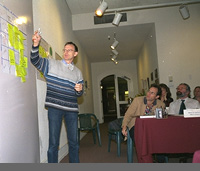For Immediate Release
Susan Barich
Director of Communications
Silicon Valley World Internet Center
650-462-9800
barich@worldinternetcenter.com
IBM'S BOB SUTOR AND OTHER INDUSTRY EXPERTS TELL
COMBINED LIVE AND WEBCAST AUDIENCES OF NEARLY 250 THAT STANDARDS
ARE ESSENTIAL TO INTEROPERABILITY ON THE INTERNET
January 25, 2001, Palo Alto, Calif. -- In a live webcast produced
last week by The Silicon Valley World Internet Center (http://www.worldinternetcenter.com)
and its Executive Sponsor, IBM Corporation (http://www.ibm.com),
IBM's Director of e-Business Standards Strategy Bob Sutor and Internet
standards experts from Sun Microsystems (http://www.sun.com),
Red Hat, Inc. (http://www.redhat.com),
The Open Group (http://www.opengroup.org),
and Microsoft Corporation (http://www.microsoft.com),
agreed that interoperability is key to communication on the Internet,
and that tested, certified standards are essential to that ability
to communicate.
" Communication, which I maintain is really the most important
part of this whole thing, should be independent of programming language
used, and XML is key," said Sutor. Interoperability is essential,
and the only way you are going to get interoperability is via standards."
"A standard is a way of doing things that many people use and
which a guarantor protects from monopolization," said Simon Phipps,
chief software evangelist at Sun Microsystems. "Today, standards
turn technologies into business opportunities, and the future of
our industry depends on open, community-based cooperation."
Phipps said that at the beginning of the 21st Century, the way
standards come about has changed from the '80s and '90s. In the
80s, standards were written by small expert groups, in the 90s they
were agreed to by companies, but in the 21st Centry they will be
devised by communities, such as the Linux or JavaTM technology communities.
"We're moving in a fast-paced, hectic world where the idea at
the crux of everything is interoperation and cooperation," said
Phipps. "It is no longer possible for any one company to tell people
how things should be. . In standards today, what matters is not
so much the technology or even the data, it is who has agreed together
to share that technology and data."
Gary Oliverio of Red Hat, Inc. talked about how, in the open-source
community, developers approach and use standards.
"If you look at the wireless industry today", said Oliverio, "we
have 5 competing standards and implementations, each overlapping
one another with similar services. Is that value for the customer?
This verticalized approach results in parallel markets where customers
cannot leverage their investment. In the open source model, the
platform standards AND implementation are agreed upon and shared,
and this assures compatibility, improved economics, and ultimately,
better customer flexibility and customer satisfaction.
Allen Brown of The Open Group suggested that innovation must be
encouraged through open standards in order to accelerate return
on investment for customers. "The customer's voice is not heard
at all, the industry must find ways to respond to the requirements
for interoperability that customers are articulating. Buyers want
to know that products are tested and that they are certified to
inter-operate." Brown said. He called for more coordination in the
testing and certification of standards.
David Turner of Microsoft told the audience that Microsoft is
looking at the concept of communication holistically.
"It's not just B2B. People need to communicate. There's communication
between devices. There's communication going on all over the place,
all the time. Our approach is to find out what is common to all
communication. From there we look to specific-use cases and build
on top of a core standard or a core set of standards in order to
enable a broad number of communication-based activities."
Turner also told the group there are three distinct layers to
Internet communication. "Understanding these layers has an impact
on understanding where you need to focus, depending on what business
you happen to be in."
XML and its derivative technologies, in Turner's view, are the
core layer. "XML allows systems to communicate and to exchange data
independent of the technologies used at either end. On top of that,
you then get a collection of standards that enable the communication,
such as SOAP and UDDI."
The third and top layer, which is very independent of the others,
is the application layer. "That's the part where you will probably
find the broadest amount of work going on, because that represents
all the millions of ways people will represent information for their
particular use."
The webcast can be viewed for the next 90 days by going to http://www.worldinternetcenter.com
and clicking on the webcast link at the bottom of the home page.
Presentations are also available on the site.
The Silicon Valley World Internet Center focuses on the advancement
of Internet-related eMarkets, technologies, people, and ideas through
the collaborative exchange of knowledge. The Center is located in
the heart of Silicon Valley and works on behalf of its sponsors
to develop programs specific to the expanding Internet Economy.
As multi-corporate, third-party venue, the Center provides a physical
and virtual forum for collaboration among technology leaders and
key end-users. The Center, a for-profit, fee-for-service corporation,
focuses primarily on the areas of eBusiness, eServices and wireless
communication.
http://www.worldinternetcenter.com
SILICON VALLEY WORLD INTERNET CENTER
The Center, a dynamic think tank, showcase and
collaboration facility for the advancement of eMarkets and Internet-related
technologies, is currently sponsored by key companies in the Internet
revolution: Amdocs, Inc., Deutsche Telekom, Fujitsu, Hewlett-Packard
Company, IBM Corporation, Metiom, SAP, and Sun Microsystems.
|
